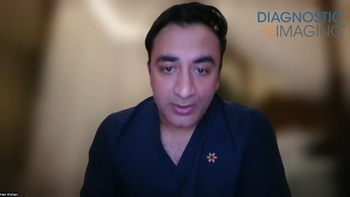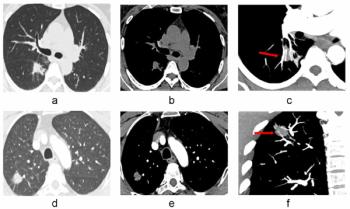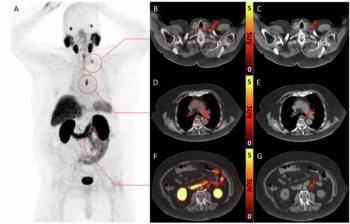
War of words erupts anew over coming release of CTs
The battle over CT slices, which has ebbed and flowed these past six years with each new generation of scanner, has reached a new pitch. The diversity of scanners now approaching the marketplace has prompted vendors to massage the language used to
The battle over CT slices, which has ebbed and flowed these past six years with each new generation of scanner, has reached a new pitch. The diversity of scanners now approaching the marketplace has prompted vendors to massage the language used to describe CT performance.
The coming breed of superpremium CTs is no longer being described exclusively as multislice or even multidetector row, which in recent years had gained favor in some corners of the community. "Volumetric CT" has popped up on the radar screen and, last week, "multichannel."
The latter term appeared in a Webcast hosted by the American Roentgen Ray Society and Philips Medical Systems June 9. Three presenters, each a Philips luminary, described their experiences with 40-slice technology.
In his opening remarks, Dr. Jonas Rydberg, an associate professor of radiology at Indiana University, argued the case for referencing multichannel CT when addressing Philips' top tier Brilliance scanner. Multislice CT is the everyday term used to denote this technology. But the power of the scanner is really reflected in the number of electronic data acquisition channels in the detector package, he said. The number of channels dictates the number of slices and, ultimately, the area that can be covered in a set period of time.
"So whenever we are comparing different scanners, the focus must always be on the number of channels," Rydberg said. "Therefore, multichannel CT is the most correct term to use."
Doing so plays into Philips' hands. The company's Brilliance has 40 channels, eight more than Toshiba's, which has 32. Conversely, use of the term multidetector row benefits Toshiba, whose flagship Aquilion has 64 detector rows, 24 more than Philips' Brilliance. Using the term multislice would benefit Siemens, whose Sensation 64 uses a flying focal spot and 32 detector rows to create 64 slices per rotation.
The wildcard in this is GE's Lightspeed VCT (volumetric CT). An industry rumor, reportedly based on statements made by a GE representative to a prospective customer, states that the first version of GE's Lightspeed VCT, due later this year, will be equipped with only 32 channels but expanded to 64 channels a year after its release.
Alerted to the rumor by DI SCAN, Brian Duchinsky, GE Healthcare general manager for Global CT, replied with an e-mail describing the company's proprietary detector.
"GE Healthcare's Lightspeed VCT system is enabled by the V-Res detector that delivers high-resolution and wide coverage simultaneously," he said. "V-Res is a true 64-channel detector covering 40 millimeters with 0.625-mm slices."
Executives in Philips' CT division predict a shadowy use of statements designed to give their adversaries an advantage over Philips' Brilliance. They are concerned that some competitors are trying to mislead customers to buy time until their products are more evolved.
"Siemens and GE are using interesting maneuvers in the market space, trying to redefine what a slice is and what 'n' number of slices on a scanner really is," said Jim Fulton, vice president of Philips' CT global marketing. "Quite frankly, the majority of the marketplace does get confused by those things."
Fulton asserts that Philips currently has the highest performance CT scanner and that its engineers will keep the company in that position well into the future. One of those future advances may be jog mode, which boosts coverage from the current 40 mm per rotation to 80 mm. This advanced capability was described briefly by a luminary during the June 9 Webcast sponsored by Philips and the ARRS.
"By the time our competitors come up with the next thing, so will we," he said.
Coverage should be the key factor to consider when sizing up CT scanners, according to Fulton. Coverage per rotation determines the speed of the scan and temporal resolution. Ultimately, the goal is to achieve enough coverage to capture an entire organ in a single sweep. That may be years away and possible only with a flat-panel detector, but the coming crop of scanners takes a big step in that direction, he said. The problem is that the marketplace is hung up on slices. Philips is trying to do something about it.
"We are working on ways of trying to avoid the slice question," he said.
The emphasis by Rydberg on the term multichannel CT is in line with that approach. Efforts by GE, most obviously the company's decision to give its new Lightspeed a volumetric moniker, reflect that same objective.
This brewing cacophony of CT jargon could have a positive effect, if it focuses the imaging community on the ultimate goal of radiology-enhancing clinical practice. But CT vendors will have to find convincing evidence of that effect. They may have hurt themselves with arguments over the past few years that 10 or even six-slice CTs are economical alternatives to 16-slice scanners, capable of doing virtually any kind of procedure short of cardiac imaging.
A technology planner for 10 California hospitals, writing in response to a DI SCAN commentary (SCAN 6/2/04), decried this practice. He noted that even as the clinical value of 16-slice scanners was being analyzed by buyers, vendors were preparing to launch the next generation of systems. He opined that this as "just another example of a society being driven by 'bigger must be better.'"
If the new generation of CTs is to catch on, vendors will have to document a clinical advantage over the previous generation. In the Webcast sponsored by Philips and the ARRS, Rydberg and luminaries at Carmel Hospital in Israel and the University Medical Center Utrecht, the Netherlands, took a swing at doing exactly that.
Rydberg described how single-breath-hold scans possible on the 40-slice Brilliance brought out detail not seen on axial images. Three-D reformatting generates striking results, he said. Such reformatting of lung data, performed by Rydberg, showed a blood vessel surrounding a lung tumor.
"The Brilliance 40 is driving a paradigm shift in CT practice," he said. "From now on, we will scan in a different way. We will do our routine postprocessing in a different way. We will read differently, and we will even store (data) differently."
Dr. Nathan Peled, head of radiology at Carmel Hospital, compared his experience examining 140 patients with the Brilliance 40-slice scanner to that of using a 16-slice system. He concluded that the 40-slice scanner allows shorter breath-holds, reduced motion artifact, and reduced doses of injected contrast.
"These qualities are especially important in cardiovascular imaging," he said.
Dr. Mathias Prokop, an associate professor of radiology at the University Medical Center Utrecht, said 40-slice scans provide the raw material to make the jump from morphology to physiology. This is especially apparent in perfusion imaging.
"We are able to freeze cardiac motion and get optimally sharp images and, therefore, optimal information about functional movement of the heart," he said. "Ultimately, we would like to see better treatment planning and better, more secure, and faster diagnoses."
In the months ahead, vendors will formalize arguments to promote their scanners. One will involve the use of terms favorable to their own particular technologies. The other will attempt to demonstrate the clinical efficacy of the equipment. One or the other may predominate, but early signs indicate that the coming battle for market dominance will involve both types of arguments. It will be up to the customer base to make sense of it all.
Newsletter
Stay at the forefront of radiology with the Diagnostic Imaging newsletter, delivering the latest news, clinical insights, and imaging advancements for today’s radiologists.






























